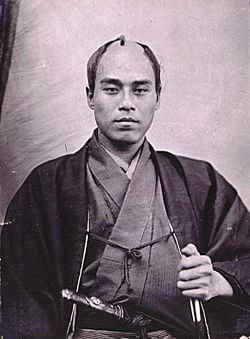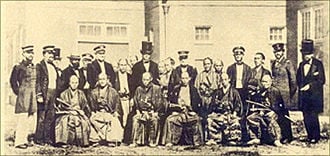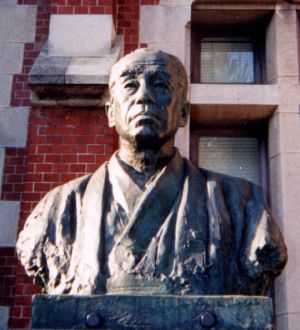Fukuzawa Yukichi
| Yukichi Fukuzawa |
|---|
| Born |
| January 10, 1835 Osaka, Japan |
| Died |
| February 3, 1901 Japan |
- This is a Japanese name; the family name is Fukuzawa.
Fukuzawa Yukichi (福澤 諭吉 January 10, 1835 – February 3, 1901) was a Japanese author, writer, teacher, translator, entrepreneur and political theorist and founder of the Keio University whose ideas about government and social institutions made a lasting impression on a rapidly changing Japan during the period known as the Meiji Era. He is regarded as one of the most influential thinkers in Japan and during the Meiji Restoration, which is a source of pride for many modern day Japanese people. He is regarded as one of the founders of modern Japan, and is highly respected in Japan.
Early Life
Fukuzawa was born into an impoverished low-ranking samurai family of the Nakatsu clan in Osaka in 1835. His family was poor following the early death of his father. At the age of 14, Fukuzawa entered a school of Dutch studies (Rangaku). In 1853, shortly after Commodore Matthew C. Perry's arrival in Japan, Fukuzawa's brother (the family patriarch) asked Fukuzawa to travel to Nagasaki, where the Dutch colony at Dejima was located. Fukuzawa was instructed to learn the Dutch language in order to study European cannon designs and gunnery techniques.
Although Fukuzawa did travel to Nagasaki, his stay was brief as he quickly began to outshine his host in Nagasaki, Okudairi Iki. Okudairi planned to get rid of Fukuzawa by writing a letter saying that Fukuzawa's mother was ill. Seeing through the fake letter Fukuzawa planned to travel to Edo and continue his studies there because he knew he would not be able to in his home domain, Nakatsu, but upon his return to Osaka, his brother persuaded him to stay and enroll at the Tekijuku school run by physician and rangaku scholar Ogata Koan. Fukuzawa studied at Tekijuku for three years, and became fully proficient in the Dutch language. In 1858, he was appointed official Dutch teacher of his family's domain, Nakatsu, and was sent to Edo to teach the family's vassals there.
The following year, Japan opened up three of its ports to American and European ships, and Fukuzawa, intrigued with Western civilization, traveled to Kanagawa to see them. When he arrived, he discovered that virtually all of the European merchants there were speaking English rather than Dutch. He then began to study English, but at that time, English-Japanese interpreters were rare and dictionaries nonexistent, so his studies were slow.
The Tokugawa bakufu decided to send envoys of the Shogun to the United States, and Fukuzawa volunteered his services to Admiral Kimura Yoshitake. Kimura's ship, the Kanrin Maru, which arrived in San Francisco, California in 1860. The delegation stayed in the city for a month, during which time Fukuzawa had himself photographed with an American girl (one of the most famous photographs in Japanese history), and also found a Webster's Dictionary, from which he began to seriously study the English language.
Fukuzawa became an official translator for the bakufu upon his return in 1860. Shortly thereafter he brought out his first publication, an English-Japanese dictionary which he called "Kaei Tsūgo" (translated from a Chinese-English dictionary) which was a beginning for his series of later books. In 1862, he visited Europe, as one of the two English translators in the 40 man embassy sent by the Tokugawa bakufu. Negotiations were made in France, England, Holland, Prussia, & finally Russia. They were almost gone an entire year. In 1867, he returned to America, this time visiting Washington, D.C. and New York City as part of a team of negotiators.
The information collected during these travels resulted in his famous work Seiyo Jijo ("Conditions in The West"), which he published in ten volumes in 1867, 1868 and 1870. The books described western culture and institutions in simple, easy to understand terms, and were an immediate best seller. Fukazawa was soon regarded as the foremost expert on all things western, and led to his decision that his mission in life was to educate his countrymen in new ways of thinking, which in turn, would strengthen Japan and enable it to resist the threat of European imperialism.
Works
Possibly Fukuzawa's writings were his greatest contribution to the Meiji period. Between 1872 and 1876, he published 17 volumes of Gakumon no Susume ("An Encouragement of Learning" or more literally "of Studying"). In these texts, Fukuzawa outlines the importance of understanding the principle of equality of opportunity and that study was the key to greatness. He was an avid supporter of education and founded one of Japan's most prestigious universities, Keio-gijuku, now known as Keio University. He believed in a firm mental foundation through education and studying. One of his most widely read article in Japan at the time is Datsu-A Ron, translated to "Argument for Leaving Asia."
In the volumes of Gakumon no Susume, Fukuzawa advocated his most lasting principle, "national independence through personal independence." Through personal independence, an individual does not have to depend on the strength of another. With such a self-determining social morality, Fukuzawa hoped to instill a sense of personal strength among the people of Japan, and through that personal strength, build a nation to rival all others. He understood that western society had become powerful relative to other countries at the time because western countries fostered education, individualism (independence), competition and exchange of ideas.
Fukuzawa also published many influential essays and critical works, one of most lasting of which is "Bunmeiron no Gairyaku" ("An Outline of a Theory of Civilization") published in 1875, in which he details his own theory of civilization. According to Fukuzawa, civilization is relative to time and circumstance, as well as comparison. For example, China was relatively civilized in comparison to some of the Africa colonies, and European nations were the most civilized of all, at the time. Many of Fukuzawa's views were shared by colleagues in the Meirokusha intellectual society, and were published in his contributions to Meiroku Zasshi (Meiji Six Magazine), a scholarly journal he helped publish. In his books and journals, he talks greatly about the word "civilization" and what it means. He advocates move toward "civilization," which means basically material well-being as well as spiritual well-being and by elevating the human life to "higher plane," and because material and spiritual well-being correspond to knowledge and "virtue," basically "move toward civilization" is the advancement and pursuit of knowledge and virtue themselves. He advocates people can find the answer to their life or their present situation from "civilization." He also says, the difference between the weak and the powerful and large and small is just a matter of difference between their knowledge/education. He also basically says that the advance of Japan shouldn't be just importing of foreign/new guns and materials, but most importantly the advancement of knowledge to establish firm basis for knowledge and education above material things, which would eventually take care of the material necessities. He also talks of Japanese concept of being practical and/or pragmatic (jitsugaku) and building of things that are basic and useful to other people as another piece on his writings. Therefore basically "civilization" is furthering of knowledge/education and nothing more.
Criticism
Fukuzawa was later criticized as a supporter of Japanese imperialism because of his essay "Datsu-A Ron" ("Leaving Asia") published in 1885, as well as for his support of the First Sino-Japanese War (1894-1895). Yet, "Datsu-A Ron" was actually a response to a failed attempt by Koreans to organize an effective reform faction, an attempt he had supported. He had invited young Korean aristocrats to his school. Yet, they squandered their time and money on getting drunk and buying prostitutes and after Fukuzawa tightened their allowance, they attempted a failed robbery of a school safe. The essay was published as a withdrawal of his support. Nevertheless the assistance provided to radical Koreans during this era was never intended to lead to complete independence for the peninsula, but on the contrary sought to bring Korea under ever greater Japanese influence. This was amply demonstrated by the power-plays undertaken in Korea by both Koreans supported by Fukuzawa and the Imperial Japanese Army during the First Sino-Japanese War.
His enthusiastic support of the First Sino-Japanese War had much to do with his opinions about modernization. Like many of his peers in the government, Fukuzawa ultimately believed the modernization of Asia could ultimately only be achieved by force. He believed that China suffered from archaic and unchanging principles and would be unable to change under its own power. At the time of the war, foot binding was still the practice in China, opium had been sold on street, political institutions were corrupt, and unable to fend off foreign incursions, China was selling national interests such as railroads and taxation to pay foreign debts. Japan, similarly, suffered the humiliation of having to endure unequal treaties with the Western powers, to avoid the fate of China, Fukuzawa hoped a display of military prowess would sway public opinion in the West towards treaty revision. In his hopes for a strong Japan, Fukuzawa saw the Asian countries around Japan as both dangers and opportunities.
"In my view, these two countries [China and Korea] cannot survive as independent nations with the onslaught of Western civilization to the East. . . It is not different from the case of the righteous man living in a neighborhood of a town known for foolishness, lawlessness, atrocity, and heartlessness. His action is so rare that it is always buried under the ugliness of his neighbors' activities," Fukuzawa wrote in "Datsu-A Ron."
Legacy
Fukuzawa's most important contribution to the reformation effort, though, came in the form of a newspaper called Jiji Shimpo, which he started in 1882, after being prompted by Inoue Kaoru, Okuma Shigenobu, and Ito Hirobumi to establish a strong influence among the people through publishing. All agreed the government should take the form of a national assembly, and as reforms began, Fukuzawa, whose fame was already unquestionable, began production of Jiji Shimpo, which received wide circulation, encouraging the people to enlighten themselves and to adopt a moderate political attitude towards the change that was being engineered within the social and political structures of Japan. He translated many books and journals to Japanese, including on wide variety of subjects for instance such as chemistry, arts, military, society from foreign languages and has published many books (in multiple volumes) and journals himself describing western society, his own philosophy and change, etc.
Fukuzawa's ideas about individual strength and his knowledge of western political theory, as presented in his writings, were instrumental in motivating the Japanese people to embrace change. He may well have been one of the most influential personalities in the modernization of Japan and one of the most progressive thinkers in Japan. He is regarded as one of the leaders of the Meiji Enlightenment movement. Fukuzawa never accepted a government position, and remained a private citizen all of his life. By the time of his death, he was revered as one of the founders of modern Japan. All of his work was written and was released at a critical juncture in the Japanese society and uncertainty for the Japanese people about their future after the signing of the Unequal treaties, their realization in the weakness of the Japanese government at the time (Togukawa Shogunate) and its inability to repel the American and European influence. It should also be noted that there were band of groups of samurais, that tried to forcefully remove the Americans and Europeans and their friends by force such as through murder and destruction, so Fukuzawa was also in danger of his life. One of his colleagues lost his life to the group, because of the same stance he took that is similar to Fukazawa's. He came in a time in when whether the Japanese people should be bitter about the American and European forced treaties and "imperialism", or understand and move forward, and the latter took effect and he helped greatly to make that move.
Fukuzawa appears on the current 10,000-yen banknote and has been compared to Benjamin Franklin in the United States, interestingly since Franklin appears on the similarly-valued $100 bill. Although all other figures appearing on Japanese banknotes changed when the recent redesign was released, Fukuzawa remained on the 10,000-yen note.
Yukichi Fukuzawa's former residence in the city of Nakatsu in Ōita Prefecture is a Nationally Designated Cultural Asset. The house and the Yukichi Fukuzawa Memorial Hall are the major tourist attractions of this city.
Further reading
- Japan: A Documentary History
- Pride and Independence: Fukuzawa Yukichi and the Spirit of the Meiji Restoration
- Fukuzawa biography at UNESCO (PDF)
- The Autobiography of Yukichi Fukuzawa. NY: Columbia University Press, 1966. Revised translation by E. Kiyooka.
External links
de:Fukuzawa Yukichi es:Fukuzawa Yukichi fr:Yukichi Fukuzawa ko:후쿠자와 유키치 nl:Fukuzawa Yukichi ja:福澤諭吉 pl:Fukuzawa Yukichi vi:Fukuzawa Yukichi zh:福泽谕吉
Credits
New World Encyclopedia writers and editors rewrote and completed the Wikipedia article in accordance with New World Encyclopedia standards. This article abides by terms of the Creative Commons CC-by-sa 3.0 License (CC-by-sa), which may be used and disseminated with proper attribution. Credit is due under the terms of this license that can reference both the New World Encyclopedia contributors and the selfless volunteer contributors of the Wikimedia Foundation. To cite this article click here for a list of acceptable citing formats.The history of earlier contributions by wikipedians is accessible to researchers here:
The history of this article since it was imported to New World Encyclopedia:
Note: Some restrictions may apply to use of individual images which are separately licensed.



